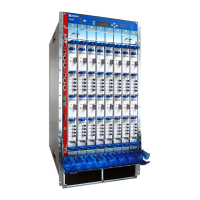5.
Installing the Quiet Upper Front Fan Tray on page 296
6.
Upgrading the Standard Rear Fan Tray to a Quiet Rear Fan Tray on page 297
Upgrading the Standard Lower Front Fan Tray to a Quiet Lower Front Fan Tray
Each standard front fan tray weighs about 18.6 lb (8.4 kg). Each quiet front fan tray
weighs about 17.8 lb (8.1 kg).
1. Attach an electrostatic discharge (ESD) grounding strap to your wrist, and connect
the strap to one of the ESD points on the chassis.
2. Unwrap any PIC cables from the spools on the cable management system and remove
the cables from the tray. Arrange the cables so that they do not block the cable
management system and tray, and secure them with temporary fasteners so that
they are not supporting their own weight as they hang from the connector.
CAUTION: Do not let fiber-optic cable hang free from the connector. Do
not allow fastened loops of cable to dangle, which stresses the cable at
the fastening point.
3. Simultaneously pull the two releases on the cable management system. Lift it up and
outward to lock it in place to access the lower fan tray.
4. Rearrange the PIC cables in the cable management system. For more information
about proper cable arrangement, see “Maintaining T640 PICs and PIC Cables” on
page 454.
5. Loosen the captive screws on the corners of the standard lower front fan tray faceplate.
6. Grasp the handles and pull the standard lower front fan tray halfway out of the chassis.
WARNING: To avoid injury, keep tools and your fingers away from the fans
asyou slide the fan tray out of the chassis. The fansmight still be spinning.
7. When the fans stop spinning, place one hand under the standard lower front fan tray
to support it and pull the fan tray completely out of the chassis.
8. Locate the fan tray labeled FAN-T-FBOT-S LOWER FANTRAY.
9. Press the two latches located on each side of the quiet lower front fan tray up, and
insert the fan tray straight into the lower front fan tray slot. See Figure 134 on page 294
293Copyright © 2017, Juniper Networks, Inc.
Chapter 26: Replacing Cooling System Components

